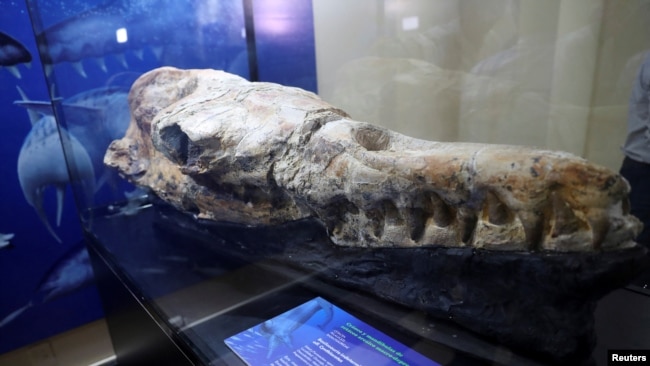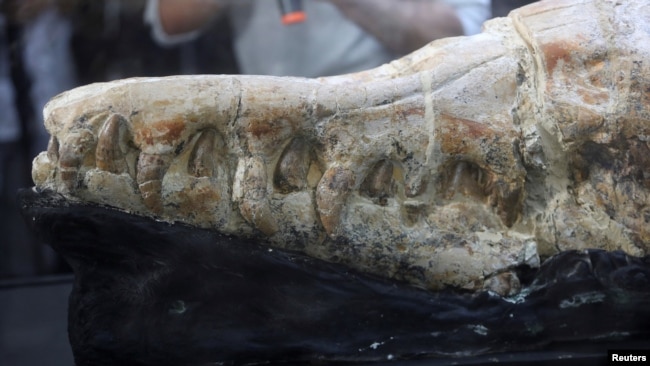鯨の祖先
体長は約12メートルもあったとされる”バシロサウルス”。
大きな蛇のように動いかもしれないとされる”王様のトカゲ”の意味を持つ巨大な鯨が、大海原をザブーンとうねりながら進む姿を想像するだけで、ワクワクしますね!!!
VOAで英語を学び、ひととき古代の海に潜ってみましょう!!!
ペルーの科学者が巨大なクジラの祖先を発見(和訳)
Scientists in Peru Discover a Huge Whale Ancestor
March 24, 2022

オクカヘ砂漠で発見され、自然史博物館に展示されている3600万年前のバシロサウルスの化石(ペルー・リマ、2022年3月17日)。(REUTERS/Sebastian Castaneda)
ペルーの科学者たちが、現代の鯨の祖先の頭蓋骨を発見しました。
この頭蓋骨の化石は、約3600万年前のものと考えられています。研究者によると、この発見は、この動物がかつてペルー南部のオクカヘ砂漠を覆っていた海に住んでいたことを示唆しているということです。
科学者たちは、昨年掘り起こされた頭蓋骨は良い状態であったと報告しています。ペルー国立サンマルコス大学の古生物学主任であるロドルフォ・サラス氏は、この頭蓋骨には、一連の長くとがった歯があると述べています。サラス氏はこの発見について記者団に話しました。
科学者たちは、古代の哺乳類はクジラ類に属するバシロサウルスであると言いいます。これは、クジラ、イルカ、イルカなどの現代の水生生物を含む同じ科です。
バシロサウルスとは”王様のトカゲ”という意味で、体長は約12メートルあったと考えられています。しかし、その長い体は大きな蛇のように動いたかもしれませんが、爬虫類ではなかったと研究者たちは言っています。
サラス氏はこの動物を”海の怪物”と呼び、バシロサウルスの新種に属する可能性があると言います。「餌を探しているときには、確かに多くの損害を与えました」と付け加えています。
この頭蓋骨はすでに同大学の博物館で公開されています。
科学者たちは、最初のクジラ類は約5500万年前に陸上で生活していた哺乳類から進化したと考えています。サラス氏は、古代のバシロサウルスが死に絶えたとき、その頭蓋骨はおそらく海の底に沈み、すぐに埋もれて残ったのだと説明しています。
「この時代、オクカヘでは化石化の条件が非常に良かったのです」とサラス氏は話しています
Scientists in Peru Discover a Huge Whale Ancestor
Scientists in Peru have discovered the skull of an ancestor of modern-day whales.
The fossilized skull is believed to be about 36 million years old. Researchers say the discovery suggests that the animal lived in an ocean that once covered Peru’s southern Ocucaje desert.
The scientists reported the skull was in good condition when dug up last year. It has a series of long, pointy teeth, said Rodolfo Salas, chief of paleontology at Peru’s National University of San Marcos. Salas spoke to reporters about the discovery.
Scientists say the ancient mammal was a basilosaurus, which belongs to the cetacean family. This is the same family that includes modern water creatures like whales, dolphins and porpoises.
The name basilosaurus means "king lizard" and the animal is thought to have been about 12 meters long. But it was not a reptile although its long body might have moved like a large snake, the researchers said.
Salas called the animal "a marine monster" that may belong to a new species of basilosaurus. "When it was searching for its food, it surely did a lot of damage," he added.
The skull is already being shown at the university's museum.
Scientists believe the first cetaceans evolved from mammals that lived on land about 55 million years ago. Salas explained that when the ancient basilosaurus died out, its skull likely sank to the bottom of the ocean, where it was quickly buried and remained.
"Back during this age, the conditions for fossilization were very good in Ocucaje," Salas said.
Words in This Story
skull – n. the part of the head, made of bone, that protects the brain
fossil – n. part of an animal or plant that lived a long time ago that has been preserved in rock
mammal – v. a kind of animal that feeds milk to its young and that usually has hair or fur covering most of its skin
marine – adj. found in or relating to the sea
species – n. a group of animals or plants that are similar and can produce young animals or plants
evolve – v. to develop or make something develop over time

